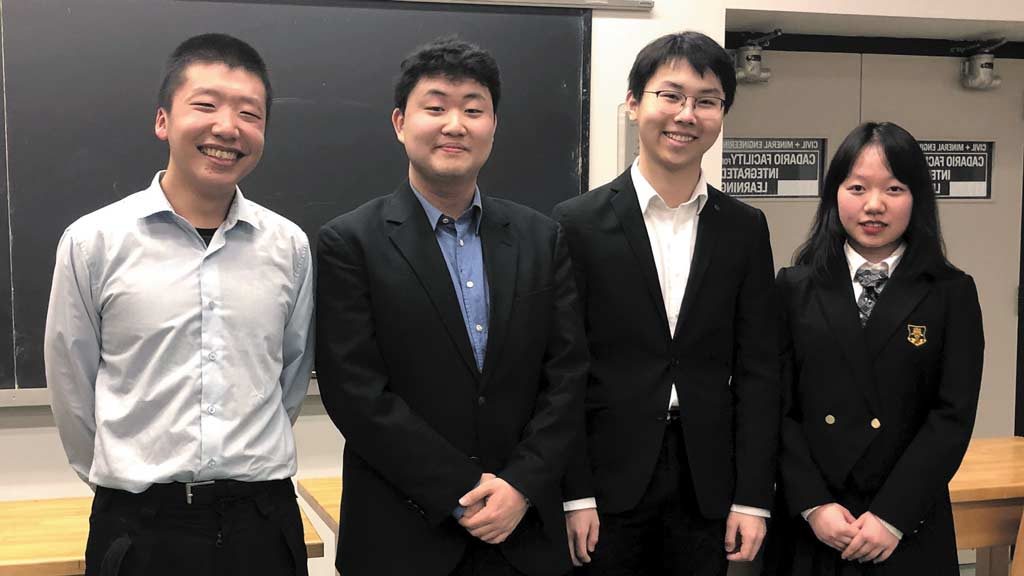Civil engineering students at the University of Toronto (U of T) have come up with some innovative HVAC and electrical ideas to cut energy use at the Christie Refugee Welcome Centre (CRWC) in downtown Toronto.
The suggestions were presented by teams during the third annual Sustainable Building Design Case Competition sponsored by the U of T student chapter of the Canadian Electrical Contractors Association (CECA). CECA represent the interests of more than 8,000 electrical contractors across Canada.
Students were asked to come up with ways to reduce energy use at the CRWC by 60 per cent. Ideas included everything from a heat recovery ventilator, to smart power strips with digital timers and electric furnaces. They also devised strategies to get the community engaged through social media platforms and interactive games.
“Some were better than others, but they came up with a great variety of solutions and ideas,” says Brenda McCabe, one of the four judges and a professor in the civil and mineral engineering department at U of T. “Students came up with a lot of novel ideas. As we get experienced, we tend to go back to the same old solutions, but they aren’t bound by that and might come up with something that no one else has really considered.”
Two teams participated in the competition. The winning team consisted of second-year civil engineering students Ziyi (Jason) Wang and Jiating (Chelsa) Lou. Participants on the other team were Paul Go, a fourth-year civil engineering student, and Bo Zhao, a first-year student.
Students were given one week to work on the project and come up with energy-saving ideas. They had information on energy use, lighting, plug loads and HVAC from an energy audit project on the CRWC that was done by engineering students two years ago. Students were hard at work for a week, creating energy reduction solutions and strategies to spread energy efficiency awareness.
Noah Cassidy, a civil engineering student and organizer with the U of T CECA student chapter, says the competition is aimed at increasing interest in the construction industry and students on both teams came up with several interesting ways of saving energy at the shelter which helps homeless refugees.
Many of the solutions were focused on reducing the heating energy use of the building, he says, as heating is the largest use of energy at the centre and for many buildings in Canada.
The students suggested the use of heat recovery ventilators that transfer heat from old indoor air to fresh air coming in from outside. The process avoids dumping usable heat outside, reducing the work the furnace must do to heat up incoming air.
Smart power strips with digital timers were also recommended, says Cassidy, as they turn off equipment when it’s not in use.
“Automatic timers mean the operators of the appliances connected to the strip don’t have to turn it off themselves.”
Students also suggested that electric furnaces be installed, as they are inherently more efficient than natural gas furnaces and reduce the amount of input energy required to heat the house, says Cassidy.
To involve the community, the two teams recommended children’s programs be implemented that include interactive games to teach young children about limited natural resources and where they use energy. Meanwhile, Cassidy says, the students also suggested documentation be published and events held to help people understand how the retrofits helped the building and that social media be used to spread word further.
McCabe, senior vice president of the Canadian Society for Civil Engineering, says she was impressed with the ideas put forward, as students considered the short- and long-term impacts, amount of capital investment required, and what the return would be and how to make an impact with minimal cost.
“One of the great things is that our students are really engaged, and they drive this effort,” says McCabe. “They don’t depend on a faculty member to tell them what they ought to do and what the next step is. They figure it out and they do it. I think that is probably one of the greatest lessons out of this.”
The four students have now joined forces with other civil engineering students and organizers of the U of T competition to work on a submission for the international Green Energy Challenge, an event in the U.S. sponsored by ELECTRI International and the National Electrical Contractors Association (NECA), in which they must simulate all the details of a proposal for a project in their community.
Teams are challenged to design an energy upgrade for a facility that provides community services to others and show how the facility can decrease its energy consumption by incorporating energy-saving measures. They must also create a volunteer plan of interaction with the facility and demonstrate in the proposal the activity and number of hours the team volunteered towards the mission of the organization.
The team is working with Orde Street Public School in central Toronto, just a few blocks south of the U of T campus. The school, built in 1914, has about 500 students. The engineering students have done an energy audit of the building to determine where the most energy is being used and are now brainstorming ways to retrofit the school, so it is more energy efficient. Last year, a U of T proposal finished second.
Deadline for their proposal is April 30. Three finalists will be selected by the end of July and invited to give presentations in October at the NECA Convention in Chicago. The winning team will receive $4,000.



Recent Comments